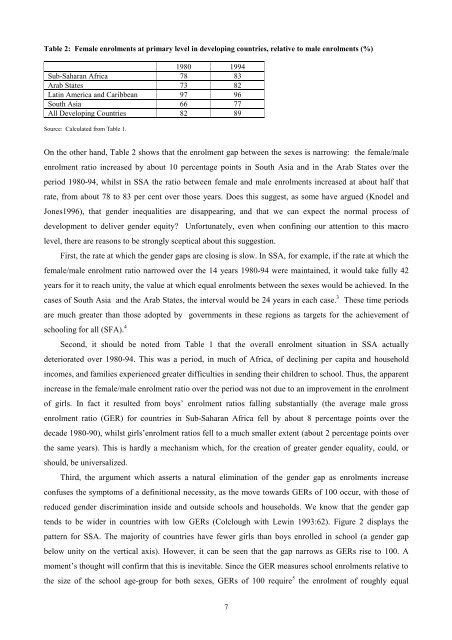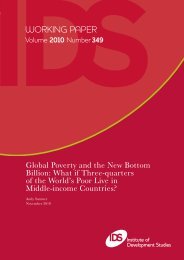GENDER INEQUALITIES IN PRIMARY SCHOOLING - Institute of ...
GENDER INEQUALITIES IN PRIMARY SCHOOLING - Institute of ...
GENDER INEQUALITIES IN PRIMARY SCHOOLING - Institute of ...
You also want an ePaper? Increase the reach of your titles
YUMPU automatically turns print PDFs into web optimized ePapers that Google loves.
Table 2: Female enrolments at primary level in developing countries, relative to male enrolments (%)1980 1994Sub-Saharan Africa 78 83Arab States 73 82Latin America and Caribbean 97 96South Asia 66 77All Developing Countries 82 89Source: Calculated from Table 1.On the other hand, Table 2 shows that the enrolment gap between the sexes is narrowing: the female/maleenrolment ratio increased by about 10 percentage points in South Asia and in the Arab States over theperiod 1980-94, whilst in SSA the ratio between female and male enrolments increased at about half thatrate, from about 78 to 83 per cent over those years. Does this suggest, as some have argued (Knodel andJones1996), that gender inequalities are disappearing, and that we can expect the normal process <strong>of</strong>development to deliver gender equity? Unfortunately, even when confining our attention to this macrolevel, there are reasons to be strongly sceptical about this suggestion.First, the rate at which the gender gaps are closing is slow. In SSA, for example, if the rate at which thefemale/male enrolment ratio narrowed over the 14 years 1980-94 were maintained, it would take fully 42years for it to reach unity, the value at which equal enrolments between the sexes would be achieved. In thecases <strong>of</strong> South Asia and the Arab States, the interval would be 24 years in each case. 3 These time periodsare much greater than those adopted by governments in these regions as targets for the achievement <strong>of</strong>schooling for all (SFA). 4Second, it should be noted from Table 1 that the overall enrolment situation in SSA actuallydeteriorated over 1980-94. This was a period, in much <strong>of</strong> Africa, <strong>of</strong> declining per capita and householdincomes, and families experienced greater difficulties in sending their children to school. Thus, the apparentincrease in the female/male enrolment ratio over the period was not due to an improvement in the enrolment<strong>of</strong> girls. In fact it resulted from boys’ enrolment ratios falling substantially (the average male grossenrolment ratio (GER) for countries in Sub-Saharan Africa fell by about 8 percentage points over thedecade 1980-90), whilst girls’enrolment ratios fell to a much smaller extent (about 2 percentage points overthe same years). This is hardly a mechanism which, for the creation <strong>of</strong> greater gender equality, could, orshould, be universalized.Third, the argument which asserts a natural elimination <strong>of</strong> the gender gap as enrolments increaseconfuses the symptoms <strong>of</strong> a definitional necessity, as the move towards GERs <strong>of</strong> 100 occur, with those <strong>of</strong>reduced gender discrimination inside and outside schools and households. We know that the gender gaptends to be wider in countries with low GERs (Colclough with Lewin 1993:62). Figure 2 displays thepattern for SSA. The majority <strong>of</strong> countries have fewer girls than boys enrolled in school (a gender gapbelow unity on the vertical axis). However, it can be seen that the gap narrows as GERs rise to 100. Amoment’s thought will confirm that this is inevitable. Since the GER measures school enrolments relative tothe size <strong>of</strong> the school age-group for both sexes, GERs <strong>of</strong> 100 require 5 the enrolment <strong>of</strong> roughly equal7
















